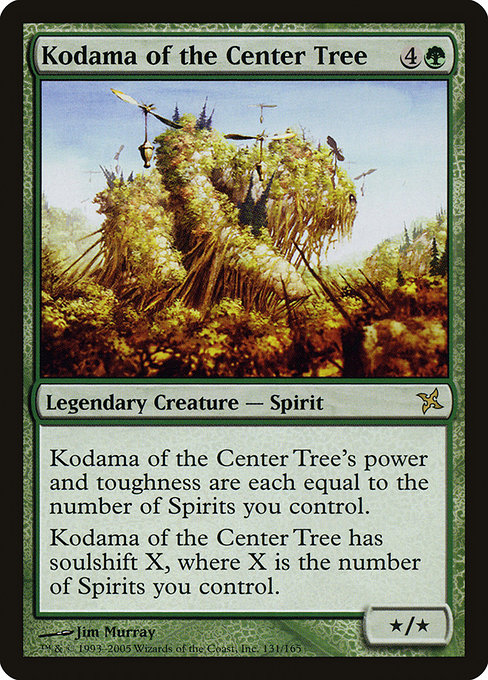
Image courtesy of Scryfall.com
Print Scarcity and Limited Editions in MTG: a Case Study
If you’ve ever chased a limited edition in Magic: The Gathering, you know that the thrill isn’t just about power on the battlefield—it’s about the story the card tells with every copy that enters a collection. Kodama of the Center Tree, a legendary Spirit from Betrayers of Kamigawa ( Bok), is a perfect lens to explore print scarcity, foil premium, and the broader culture of limited editions 🧙♂️🔥. This 2005 green behemoth isn’t just a stat line; it’s a window into how Wizards balanced design, rarity, and long-tail collector value in an era when “collectible” sometimes meant “hard to find in good condition.”
Kodama is a five-mana commitment ({4}{G}) that scales with the number of Spirits you control. In practice, that means the more your board fills with ethereal allies, the mightier Kodama becomes. Its power and toughness aren’t fixed; they’re dynamic, a thematic fit for a card that embodies a living forest where every whispering spirit adds weight to the tree’s presence. And to seal the deal, Kodama also carries Soulshift X—the classic Kamigawa mechanic—so when the card finally falls, you can retrieve a Spirit from your graveyard with mana value X or less. It’s a fragile, seasonally reflective design: your deck’s spiritual ecosystem can turn Kodama into a lethal late-game crescendo or a resilient anchor that keeps your strategy alive after a wipe. The flavor isn’t just on the art—it's baked into the rules text, which is why this card remains dear to Spirit tribal builds and EDH pods that love a good late-game recoup turn 🎲🎨.
From a print-ecosystem perspective, Kodama’s rarity is rare, and its set—Betrayers of Kamigawa—feels like a snapshot of a specific moment in MTG’s history: a time when the game leaned into a highly thematic, lore-dense block with a distinctive art direction and a tricky reminder of where and how spirits gather. The card exists in both foil and non-foil forms, with foil copies significantly rarer in the wild and earning a higher premium. In the market, you’ll notice a stark contrast: non-foil values hover around modest levels, while foil copies carry a premium that mirrors the general scarcity of premium print runs from that era. The data from Scryfall shows a modest USD price for non-foil, but a noticeably higher figure for foil—an everyday reminder of how scarcity compounds value over time 🧙♂️💎.
For players, Kodama also sits at a curious intersection of formats. It’s Legacy and Vintage-legal, and it’s Commander-legal, which means it finds a home in both casual recursions and more cutthroat old-school circles. Notably, in formats where you truly lean into tribal synergy, Kodama scales with your deck’s life force—the more Spirits you control, the more the Center Tree flexes its枝. This relationship between board state and card power is a gentle nod to why print cycles matter: in a meta where new Spirits have joined a few times since 2005, Kodama remains a relatable, evergreen strategic anchor for players who like to count bodies and souls as the game tightens its weave 🧙♂️⚔️.
In the collector’s mind, scarcity isn’t just a price tag—it’s a narrative thread: how many copies exist in pristine condition, how many foils survived the initial wave, and how many more will ever find their way into a playset. Kodama’s story is a vignette of that tension, told in green mana and centuries-old lore.
Print trends around limited editions aren’t random; they’re crafted with care—and sometimes mischief. Betrayers of Kamigawa itself arrived with a heavy thematic emphasis on spirits, betrayal, and the haunting beauty of a world where life and loss are braided. The limited nature of older sets, the relative difficulty of reprints, and the enduring appeal of Spirit-based strategies all contribute to the ongoing interest in Kodama. The card remains a cherished centerpiece for collectors who enjoy the tactile delight of foil cards, the aging charm of non-foil prints, and the overall romance of first-run magic from a beloved block 🧙♂️🔥.
If you’re considering adding Kodama to a collection or a shelf of battle-tested legends, you’re not just paying for a card—you’re investing in a story about scarcity, configuration, and the enduring joy of building a green-tinged world where every Spirit on the battlefield has a chance to echo back from the grave. The center tree is a living metaphor for MTG’s long game: players craft decks around relationships between cards, and printers craft scarcity curves around the rhythms of market demand. It’s a dance of design and desire, and Kodama is one of the most evocative dancers in that room 💚🎶.
Speaking of rhythm, a thoughtful way to enjoy this journey is to pair a tactile desk companion with the mindset of a modern collector. In that spirit, this cross-promotional mouse pad—round or rectangular and non-slip—offers a practical, stylish companion for long drafting sessions and late-night pack-opening marathons. It’s a delightful reminder that MTG isn’t just about the cards; it’s about the stories we tell around the table, the art we admire, and the little rituals we build along the way 🧙♂️🎲.
Custom Neoprene Mouse Pad Round or Rectangular Non-slipMore from our network
- https://transparent-paper.shop/blog/post/designing-beautiful-gratitude-journal-printables-for-daily-joy/
- https://crypto-acolytes.xyz/blog/post/solana-vs-ethereum-gas-fees-which-is-cheaper/
- https://blog.digital-vault.xyz/blog/post/oneirophage-dream-loop-building-a-compact-combo-deck/
- https://blog.digital-vault.xyz/blog/post/step-by-step-guide-to-building-a-youtube-ad-campaign/
- https://crypto-acolytes.xyz/blog/post/intro-to-crypto-mining-a-beginners-guide/